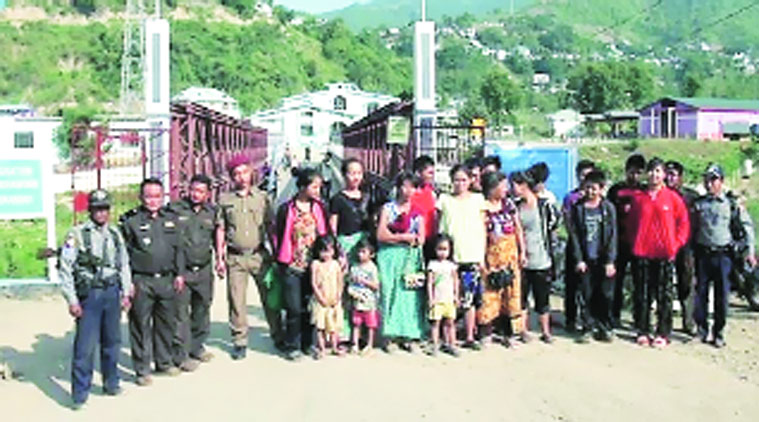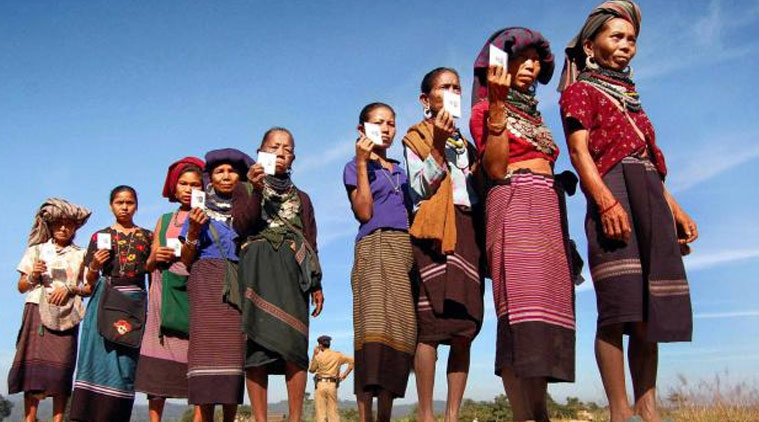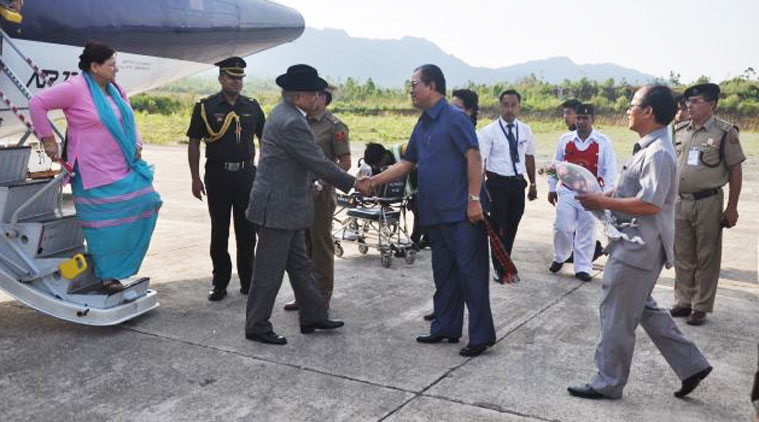The
process of repatriation of displaced Bru tribals from Tripura to
Mizoram that began in 2010 is set to be wound up. But like earlier
attempts, this phase too has seen little success.
 Displaced Bru tribals return home to Mizoram from relief camps in
Tripura during the 2013 repatriation process.
Displaced Bru tribals return home to Mizoram from relief camps in
Tripura during the 2013 repatriation process.
 Displaced Bru tribals return home to Mizoram from relief camps in
Tripura during the 2013 repatriation process.
Displaced Bru tribals return home to Mizoram from relief camps in
Tripura during the 2013 repatriation process.
By Adam Halliday
When and why were the Bru tribals of Mizoram displaced?
On October 21, 1997, militants of the Bru National Liberation Front (BNLF) murdered a forest official in Mizoram, triggering a wave of retaliatory ethnic violence from the Mizos. The Bru National Union or BNU, then the tribe’s apex political body which was demanding an autonomous tribal district, claimed 1,391 Bru houses in 41 villages were burned down and several people were raped and killed. Mizoram Police put the number of homes torched at 325 in 16 villages, and confirmed no rape or murders. Over 30,000 Brus fled to six relief camps in Tripura — Bru leaders blamed the violence, but the official and unofficial narrative in Mizoram remains that the tribals were instigated by the BNLF and BNU. The refugees lived on rations, with few avenues of employment, education and health facilities, and no entitlement to agricultural or other land.
When did the repatriation process of the displaced tribals begin?
For years, Tripura pushed Mizoram to resettle the displaced tribals. The repatriation process began in 2010, and has been monitored and financed by the union Home Ministry. Displaced Bru families willing to return have been identified and, after verified as having lived in Mizoram before 1997, handed rehabilitation packages, and resettled in the villages they had left. Where that was impossible, they were put in the nearest settlement — or at least, within the same assembly constituency.

How successful has the process been?
In November 2009, Bru militants killed a Mizo teenager at Bungthuam village just across the river from Tripura, in an act that was officially seen as an attempt to derail the planned repatriation. Fresh ethnic violence followed, and scores of Bru families fled Mizoram. When the repatriation process did start, however, among the first to return was Elvis Chorkhy, then the tallest leader among relief-camp Brus, who has, along with other leaders, assisted Mizoram in the process ever since. However, despite six formal phases of repatriation having been completed, fewer than 700 of the roughly 5,500 families believed to live in the camps have returned. This is because relief camp leaders have consistently opposed the process — sometimes by organising dharnas and roadblocks — demanding a bigger rehabilitation package and changes in resettlement provisions, and arguing that some of those who have returned have not got the land they were promised. Fears have been expressed for returnees’ security — even though, despite occasional tensions, there has been no violence. Significantly, over 1,000 families have left the camps on their own.
Why is the current repatriation process especially significant?
Mizo groups have been upset over the perceived negative publicity the Bru issue has brought. Matters came to a head before last year’s Lok Sabha elections — more than 11,000 Brus have voting rights in Mizoram, even though, Mizo groups allege, they have refused to return. A statewide bandh was called in April 2014, which helped speed up matters. In January 2015, the Home Ministry, Tripura and Mizoram agreed to a final round of repatriation, with the condition that any Brus who still refused to return would be removed from Mizoram’s electoral rolls, and rations and relief to them would be stopped. A roadmap was prepared, which was accepted by the Social Justice Bench of the Supreme Court, which is hearing a bunch of petitions related to the case. The final repatriation process began on June 2.
Where does the repatriation process stand at the moment?
Mizoram officials set up counters in Kaskau relief camp — the camp closest to Mizoram — and invited any Brus wanting to return home to come for verification. The officials waited three days, but no one turned up. The Mizoram government has said officials will now visit the Khakchangpara relief camp from June 15, and then move forward, camp by camp.
Why is the Bru repatriation experience significant?
It probably shows the difference in the ways different displaced populations are treated in India. Several other Northeast tribal groups fleeing ethnic violence have escaped being confined to relief camps, and the displaced Brus have been seeking relief on par with Kashmiri Pandits and the Sri Lankan Tamils refugees. The Brus have been in their camps for a generation, but their story remains unknown in most of India. The halting repatriation process has lessons for the handling of possible future displacement crises and resettlement efforts.
On October 21, 1997, militants of the Bru National Liberation Front (BNLF) murdered a forest official in Mizoram, triggering a wave of retaliatory ethnic violence from the Mizos. The Bru National Union or BNU, then the tribe’s apex political body which was demanding an autonomous tribal district, claimed 1,391 Bru houses in 41 villages were burned down and several people were raped and killed. Mizoram Police put the number of homes torched at 325 in 16 villages, and confirmed no rape or murders. Over 30,000 Brus fled to six relief camps in Tripura — Bru leaders blamed the violence, but the official and unofficial narrative in Mizoram remains that the tribals were instigated by the BNLF and BNU. The refugees lived on rations, with few avenues of employment, education and health facilities, and no entitlement to agricultural or other land.
When did the repatriation process of the displaced tribals begin?
For years, Tripura pushed Mizoram to resettle the displaced tribals. The repatriation process began in 2010, and has been monitored and financed by the union Home Ministry. Displaced Bru families willing to return have been identified and, after verified as having lived in Mizoram before 1997, handed rehabilitation packages, and resettled in the villages they had left. Where that was impossible, they were put in the nearest settlement — or at least, within the same assembly constituency.

How successful has the process been?
In November 2009, Bru militants killed a Mizo teenager at Bungthuam village just across the river from Tripura, in an act that was officially seen as an attempt to derail the planned repatriation. Fresh ethnic violence followed, and scores of Bru families fled Mizoram. When the repatriation process did start, however, among the first to return was Elvis Chorkhy, then the tallest leader among relief-camp Brus, who has, along with other leaders, assisted Mizoram in the process ever since. However, despite six formal phases of repatriation having been completed, fewer than 700 of the roughly 5,500 families believed to live in the camps have returned. This is because relief camp leaders have consistently opposed the process — sometimes by organising dharnas and roadblocks — demanding a bigger rehabilitation package and changes in resettlement provisions, and arguing that some of those who have returned have not got the land they were promised. Fears have been expressed for returnees’ security — even though, despite occasional tensions, there has been no violence. Significantly, over 1,000 families have left the camps on their own.
Why is the current repatriation process especially significant?
Mizo groups have been upset over the perceived negative publicity the Bru issue has brought. Matters came to a head before last year’s Lok Sabha elections — more than 11,000 Brus have voting rights in Mizoram, even though, Mizo groups allege, they have refused to return. A statewide bandh was called in April 2014, which helped speed up matters. In January 2015, the Home Ministry, Tripura and Mizoram agreed to a final round of repatriation, with the condition that any Brus who still refused to return would be removed from Mizoram’s electoral rolls, and rations and relief to them would be stopped. A roadmap was prepared, which was accepted by the Social Justice Bench of the Supreme Court, which is hearing a bunch of petitions related to the case. The final repatriation process began on June 2.
Where does the repatriation process stand at the moment?
Mizoram officials set up counters in Kaskau relief camp — the camp closest to Mizoram — and invited any Brus wanting to return home to come for verification. The officials waited three days, but no one turned up. The Mizoram government has said officials will now visit the Khakchangpara relief camp from June 15, and then move forward, camp by camp.
Why is the Bru repatriation experience significant?
It probably shows the difference in the ways different displaced populations are treated in India. Several other Northeast tribal groups fleeing ethnic violence have escaped being confined to relief camps, and the displaced Brus have been seeking relief on par with Kashmiri Pandits and the Sri Lankan Tamils refugees. The Brus have been in their camps for a generation, but their story remains unknown in most of India. The halting repatriation process has lessons for the handling of possible future displacement crises and resettlement efforts.


























